|
|
|
Sort Order |
|
|
|
Items / Page
|
|
|
|
|
|
|
| Srl | Item |
| 1 |
ID:
130001
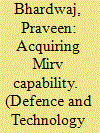

|
|
|
| 2 |
ID:
132005
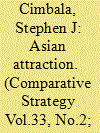

|
|
|
|
|
| Publication |
2014.
|
| Summary/Abstract |
The United States' military-strategic pivot toward Asia is motived by concerns about a rising China, about the increased significance of Asia on the world economic and political stages, and about the growing risks of nuclear proliferation and nuclear first use in that region. Nuclear Asia already numbers five acknowledged or de facto nuclear weapons states among its members: Russia, China, North Korea, India, and Pakistan. Failure to reverse North Korea's nuclear weapons status or political distrust among other powers may increase the number of Asian nuclear weapons states (including states with prospective nuclear-missile reach into Asia) to eight, creating an Asian-Middle Eastern nuclear arms race that defies containment. On the other hand, an alternative presents itself, in the form of a multilateral nuclear arms reduction agreement that would create three tiers of accepted nuclear weapons states and bar the door to new admits.
|
|
|
|
|
|
|
|
|
|
|
|
|
|
|
|
| 3 |
ID:
130459
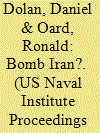

|
|
|
| 4 |
ID:
122600
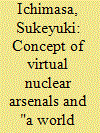

|
|
|
|
|
| Publication |
2012.
|
| Summary/Abstract |
Proposed by J. Schell and others in the Cold War era, the concept of virtual nuclear arsenals has been
a subject of debate. From the standpoint of the theory of nuclear disarmament, the concept has been
questioned on the basis of justifying the nuclear threat, infringing on the irreversibility requirement of
disarmament, and fixating the discriminatory structure of nuclear weapons. On the other hand, from
the viewpoint of the theory of nuclear deterrence, the problem of instability and feasibility inherent in
the concept and the idea of reconstructing nuclear arsenals that will decrease second strike capability
have been under harsh criticisms. Attempting to find new inter-linkages between the debates of
nuclear disarmament and deterrence theories over the vision of "a world without nuclear weapons"
proposed by the US Obama administration, this study sets out to examine the implications that the
concept of virtual nuclear arsenals may have on the current international security environment from
the two aspects of: nuclear deterrence and disarmament; and nuclear non-proliferation.
|
|
|
|
|
|
|
|
|
|
|
|
|
|
|
|
| 5 |
ID:
152188
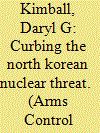

|
|
|
| 6 |
ID:
067778
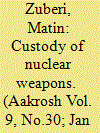

|
|
|
|
|
| Publication |
2006.
|
| Summary/Abstract |
The American experience of custody of nuclear weapons is of contemporary interest because they were initially produced under military control, and then transferred to a civilian Atomic Energy Commission (AEC) and the armed forces had to conduct a sustained campaign to wrest the custody of the stockpile. ...
|
|
|
|
|
|
|
|
|
|
|
|
|
|
|
|
| 7 |
ID:
127854
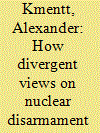

|
|
|
|
|
| Publication |
2013.
|
| Summary/Abstract |
The nuclear Nonproliferation Treaty (NPT) is facing several serious challenges. There are increasing doubts about its effectiveness in preventing the proliferation of nuclear weapons. The actions of North Korea are deeply worrying and significantly undermine the NPT edifice. The complex issue of the Iranian nuclear program and if and how it can be resolved will have serious repercussions for the treaty.
Universality is a key ingredient of the NPT's credibility, but looks more and more distant. Without India, Israel, and Pakistan, which never were parties, and North Korea, which declared its withdrawal from the treaty in 2003, the NPT's value as a security and confidence-building instrument is increasingly put into question in the regional contexts of the Middle East and Asia. Arguably its most serious challenge, however, is the extent to which it can still be considered as a framework in which to achieve nuclear disarmament. Fundamentally different and even conflicting views are apparent among the NPT membership on key aspects, such as the priority of nuclear disarmament, the demands of Article VI,[1] the definition of credible progress, and the way forward. These differences threaten the integrity of the NPT.
|
|
|
|
|
|
|
|
|
|
|
|
|
|
|
|
| 8 |
ID:
125616
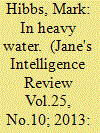

|
|
|
|
|
| Publication |
2013.
|
| Summary/Abstract |
After 10 years of design procurement, and construction, Iran's new heavy water reactor in Arak is nearing completion. Mark Hibbs explains why the project is a growing concern for those monitoring Iran's nuclear capabilities.
|
|
|
|
|
|
|
|
|
|
|
|
|
|
|
|
| 9 |
ID:
100239
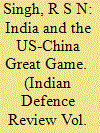

|
|
|
| 10 |
ID:
127859
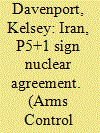

|
|
|
|
|
| Publication |
2013.
|
| Summary/Abstract |
Iran and six world powers last month achieved an apparent breakthrough in negotiations over Tehran's controversial nuclear program when the parties reached a first-phase agreement on a six-month deal that will halt Iran's most sensitive nuclear activities and increase international monitoring of its nuclear program in exchange for some relief from sanctions that have hurt Iran's economy.
|
|
|
|
|
|
|
|
|
|
|
|
|
|
|
|
| 11 |
ID:
080319
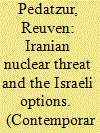

|
|
|
|
|
| Publication |
2007.
|
| Summary/Abstract |
As a result of developments including the overthrow of Saddam Hussein, Muammar
Al-Qaddafi's decision to cease WMD programs, and the weakening of the Syrian
Downloaded By: [Inst for Defence Studies & Analysis] At: 07:12 18 February 2008
military, only one potential strategic threat against Israel remains: the Iranian nuclear
program. Iran's acquisition of nuclear weapons is likely to transform the Middle
East's strategic balance, force changes in Israel's national security planning in
general and its nuclear policy in particular.
This article analyses the options open to Israel in response to a nuclear Iran, and
the advantages and disadvantages of each. Evaluation of the options available to
Israel reveals seven alternatives. In the near future, Israeli decision makers will
have to decide whether to adopt one or a mix of options ranging from preemptive
attack to unconcealed nuclear deterrence. After analysing each of these options, the
conclusion is that Israel probably will move to unconcealed nuclear deterrence in
the event of Iran completing the development and the acquisition of nuclear weapons.
|
|
|
|
|
|
|
|
|
|
|
|
|
|
|
|
| 12 |
ID:
038689
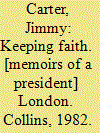

|
|
|
|
|
| Publication |
London, Collins, 1982.
|
| Description |
xiv, 622p.Hbk
|
| Standard Number |
0002166488
|
|
|
|
|
|
|
|
|
|
|
|
Copies: C:1/I:0,R:0,Q:0
Circulation
| Accession# | Call# | Current Location | Status | Policy | Location |
| 026026 | 923.173/CAR 026026 | Main | On Shelf | General | |
|
|
|
|
| 13 |
ID:
066368
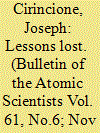

|
|
|
| 14 |
ID:
127857


|
|
|
|
|
| Publication |
2013.
|
| Summary/Abstract |
In February 1993, Russia and the United States signed an agreement on the disposition of highly enriched uranium (HEU) extracted from Russian nuclear weapons.[1] Under the terms of the deal, Russia undertook to down-blend 500 tons[2] of HEU, enough to build 20,000 nuclear warheads, over a 20-year period. The two sides agreed that the resulting low-enriched uranium (LEU) would be used as fuel by nuclear power plants in the United States, hence the informal name of the program, "Megatons to Megawatts."
In January 1994, Russia's Techsnab-export (Tenex) and the United States Enrichment Corporation (USEC), the state-run companies authorized by their respective governments to implement the deal, signed the contract. In the U.S. case, that meant that USEC was a supplier of enriched uranium to private utilities. According to assessments made at the time, the value of the entire program was expected to reach about $12 billion.
|
|
|
|
|
|
|
|
|
|
|
|
|
|
|
|
| 15 |
ID:
184370
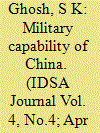

|
|
|
| 16 |
ID:
133990
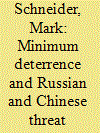

|
|
|
|
|
| Publication |
2014.
|
| Summary/Abstract |
Minimum Deterrence advocates, such as the Global ZERO report chaired by retired General James Cartwright, often urge the elimination of the U.S. triad of ICBMs, SLBMs, and bombers and minimum modernization of U.S. nuclear forces. These recommendations ignore fundamental realities. Both Russia and China have announced that they intend to increase their nuclear forces and both are modernizing their forces. Russia and China regard the U.S. as their main enemy and are arming against us. The Minimum Deterrence assumption that there is no risk of a conflict between the U.S. and Russia or China is a dangerous one. Both Russia and China have significant territorial claims against their neighbors. Russian claims to the Arctic Ocean and Chinese claims over the South China Sea are particularly troubling. China continues to threaten war over Taiwan. China has increasingly used military might to support its territorial claims in the South China Sea, creating incidents that have the potential to escalate into war. The most fundamental problem with Minimum Deterrence is that it intentionally degrades our deterrence of nuclear or other WMD attack, as well as our ability to deter nuclear escalation in a situation where the U.S. provides allies a credible nuclear umbrella. U.S. failure to provide a credible nuclear umbrella could result in Japan and, possibly other nations, deciding to go nuclear in order to protect themselves.
|
|
|
|
|
|
|
|
|
|
|
|
|
|
|
|
| 17 |
ID:
093986
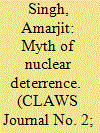

|
|
|
| 18 |
ID:
073716
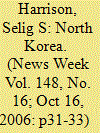

|
|
|
| 19 |
ID:
154929
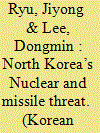

|
|
|
|
|
| Summary/Abstract |
Despite the unceasing efforts of the international community to halt North Korea’s
nuclear ambitions, North Korea’s nuclear development and missile technology
have aggressively progressed over time. Why did the efforts fail and what would
be the new direction to fix the problem, if necessary? To answer these central
questions, this paper attempts to analyze the problems of sanctions on North Korea
and assess North Korea’s nuclear development and capability. This paper suggests
that a recalibration of policy measures, including a dual–track strategy that, on the
one hand leads to internal change in the North, while on the other, results in strong
external pressure, continues to be significant for the ultimate resolution of North
Korea’s nuclear quandaries. If left alone, the nuclear situation in North Korea may
likely shift from the previously limited problem of denuclearization on the Korean
peninsula to the broader global concern of nonproliferation.
|
|
|
|
|
|
|
|
|
|
|
|
|
|
|
|
| 20 |
ID:
132000
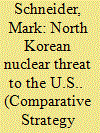

|
|
|
|
|
| Publication |
2014.
|
| Summary/Abstract |
A recent unclassified Defense Intelligence Agency (DIA) assessment stated: "DIA assesses with moderate confidence the North [Korea] currently has nuclear weapons capable of delivery by ballistic missiles." This conclusion is highly credible and not really new. North Korea was assessed to have nuclear weapons long before the actual (or at least detected) first test of these weapons in 2006. Building a nuclear weapon small enough to be carried by the relatively large payloads of North Korea's ballistic missiles is not a very difficult task today. In light of what is now known about the proliferation of a nuclear missile warhead from China to Pakistan and from Pakistan to North Korea, the North Korea defector reports about nuclear weapons development and the North Korean nuclear tests, the DIA conclusion may be an understatement. The North Korean nuclear stockpile may be significantly greater than what is usually assessed. This is of concern because the North Korean regime is the most brutal Stalinist dictatorship in the world. Moreover, while North Korea has long made occasional nuclear attack threats against the U.S. in the past, the scope, magnitude, and frequency of these threats vastly increased in 2013. Current U.S. policy, which downgrades the importance of nuclear deterrence and cuts missile defense, is not well suited to handle this threat.
|
|
|
|
|
|
|
|
|
|
|
|
|
|
|
|
|
|
|
|
|